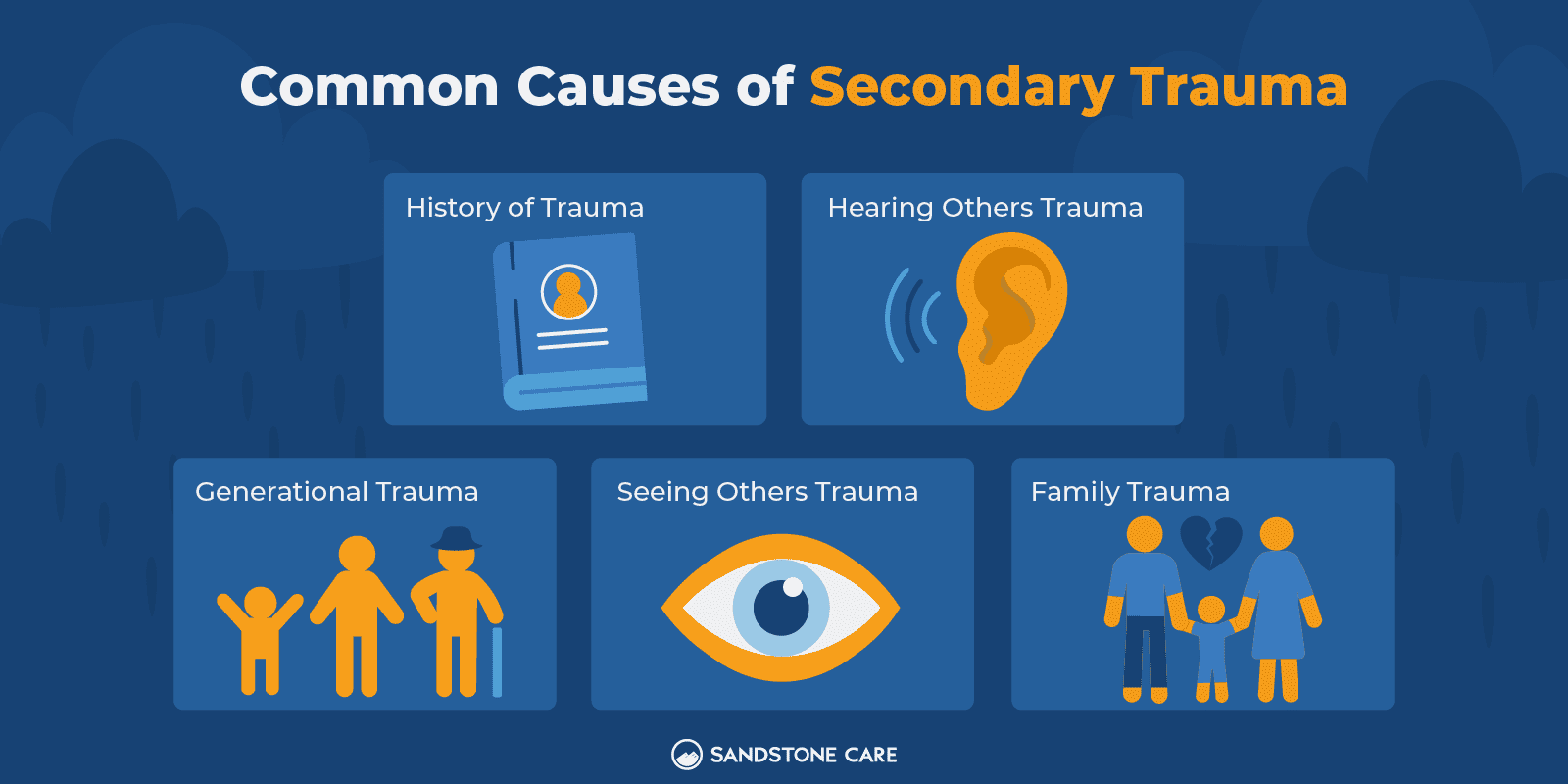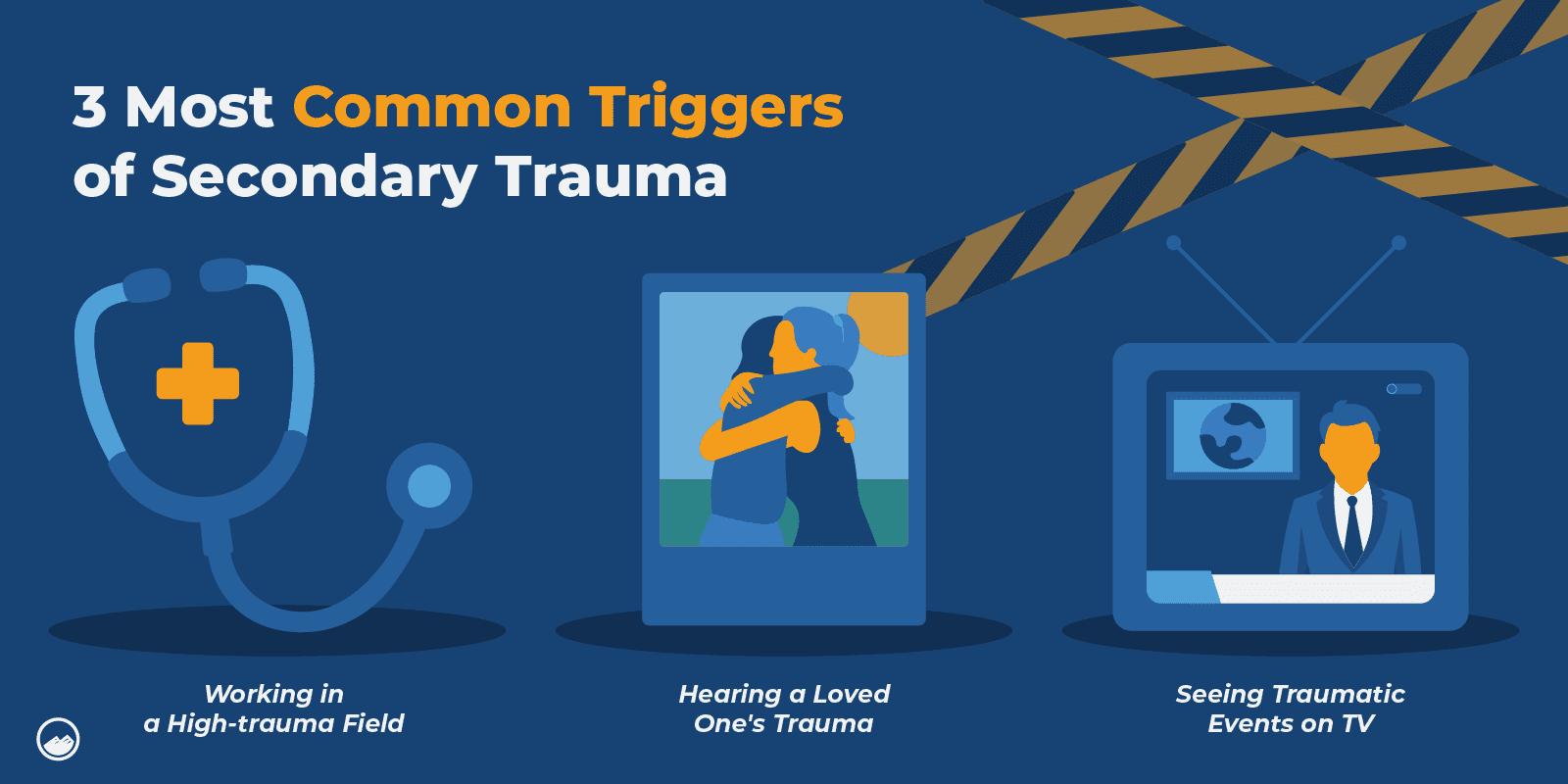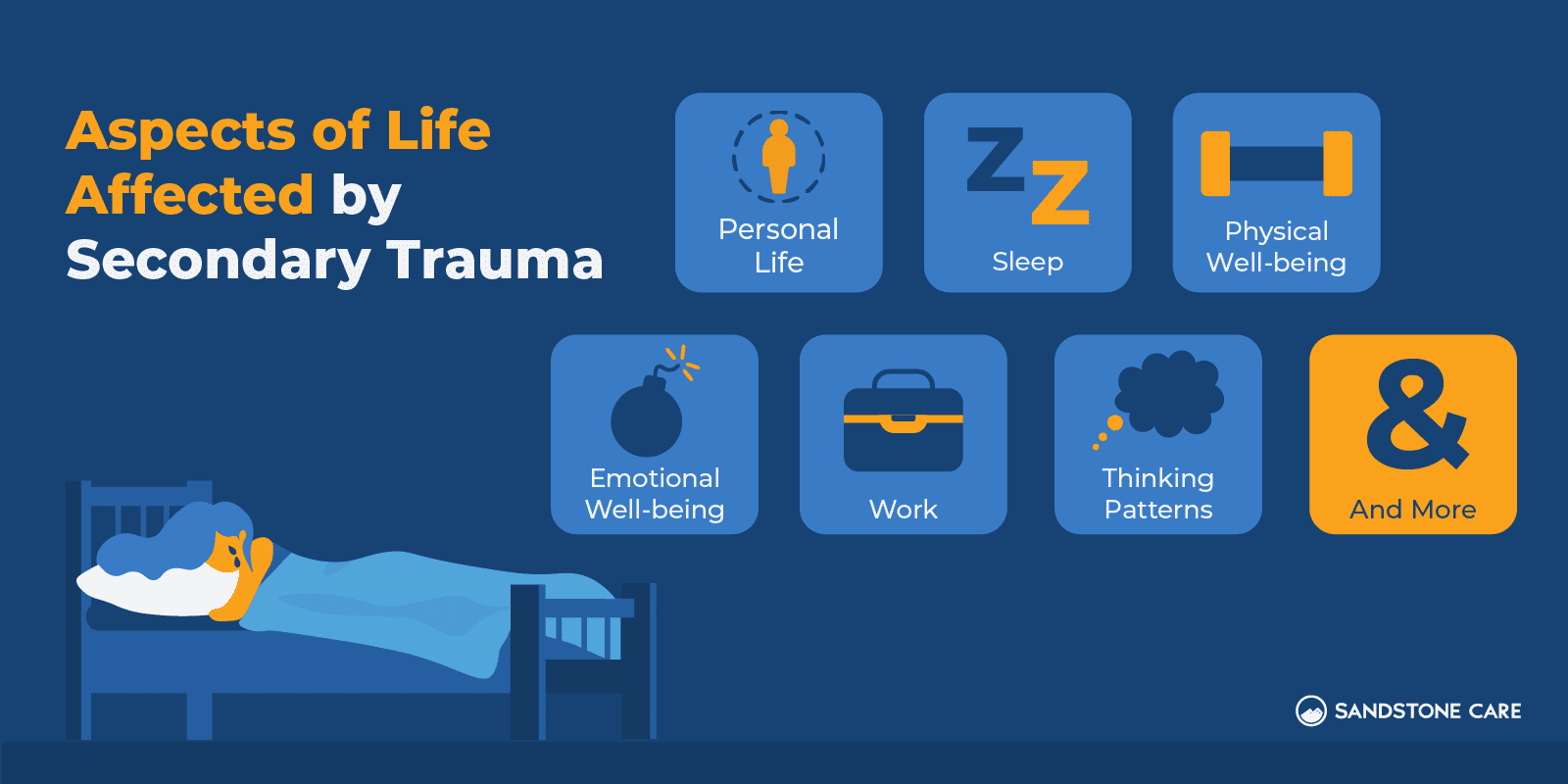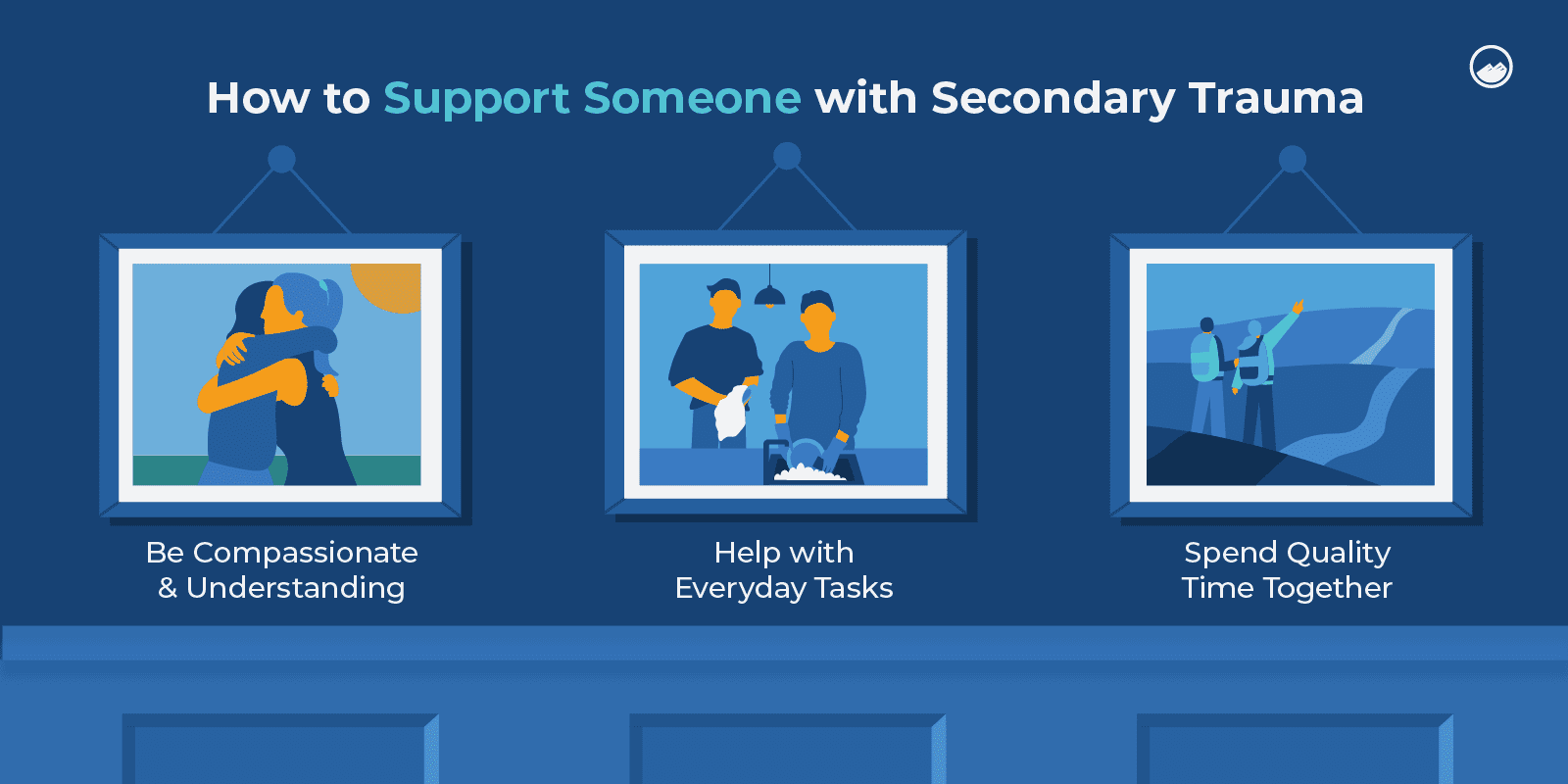Secondary Trauma
What Is Secondary Trauma?
Secondary trauma describes symptoms that can occur when a person is indirectly exposed to trauma from another person.
For example, hearing traumatic stories or being in a job where you are constantly helping people who have experienced trauma may cause you to experience symptoms like stress, anxiety, and fatigue.
Can You Be Traumatized by Someone Else’s Trauma?
It is possible to experience distress and other symptoms when you are exposed to another person’s trauma.
This reaction, known as secondary or vicarious trauma, can affect your sense of safety and view of the world.
Why Do People Get Secondary Trauma?
Secondary trauma is the brain’s stress response to witnessing or hearing about someone’s firsthand trauma.
This response can sometimes be triggered by a deep emotional connection to the person suffering. Caring deeply about those who are experiencing traumatic events can cause feelings of helplessness and emotional exhaustion.
Common causes of secondary stress can be exposure to other people’s traumatic events, which can include:
- Sexual assault
- Physical assault
- Childhood abuse or neglect
- Accidents
- Natural disasters
- Near-death experiences
- Combat or war
Other contributing factors of secondary trauma can include:
- Frequent exposure to trauma
- Relationships with people who frequently trauma dump
- Personal history of trauma
- Having a parent with trauma
- Having a child with trauma
- Isolation
- Being overworked or having demanding shifts
What Is Primary and Secondary Trauma?
Primary trauma is when the person experiences or witnesses traumatic events firsthand, while secondary trauma occurs to those who are introduced to trauma through stories, global events, or counseling careers.
Primary trauma can lead to feelings of fear and helplessness. Symptoms of primary trauma can vary in severity and can impact a person’s everyday life, mental health, and well-being.
Secondary trauma is when a person is exposed to trauma that another person directly experienced.
This can happen when a person hears the stories of someone who has experienced trauma or can be from working in a profession where you help people who have gone through trauma every single day.
For example, those who have heavy caseloads of trauma survivors, such as child welfare workers, may experience secondary trauma and burnout when they are not provided with the resources they need to heal in their work environment.
What Is Another Term for Secondary Trauma?
Secondary trauma is sometimes also referred to as compassion fatigue, secondary traumatic stress disorder, secondary traumatization, or vicarious trauma.
However, these terms can describe different things depending on what source is using them.
The central concept, however, remains the same; emotional fatigue and stress responses from repeated exposure to other people’s traumatic experiences.
Secondary Trauma Symptoms
How Do I Know if I Have Secondary Trauma?
You might have secondary trauma if you start feeling overwhelmed by emotions that mirror those of the person who experienced the trauma. Symptoms can include anxiety or feeling disconnected from your surroundings.
Common signs and symptoms of STS, or secondary traumatic stress, can include:
- Fatigue
- Emotional exhaustion
- Difficulty concentrating
- Anxiety or depression
- Lack of interest in things you used to once like
- Feelings of anger, guilt, helplessness, and numbness
- Feeling a need for perfectionism
- Withdrawal or isolation
- Difficulty sleeping
- Changes in eating habits
- Pain in muscles or body
- Feeling hyper-vigilant
What Does Secondary Trauma Feel Like?
When a person has secondary trauma, they might start to feel isolated from the people around them.
They can experience feelings of anger, guilt, helplessness, or feel numb to emotions. They may even feel shame, guilt, or self-doubt because they don’t know how they can help those who shared their traumatic experiences.
It can be difficult to think about other things outside of the person; they might become preoccupied with thoughts of the person’s trauma or become paranoid that it could happen in their own lives.
What Are 3 Signs of Secondary Trauma?
The three most common signs of secondary trauma can include fatigue, reduced productivity, and avoiding others.
Some who experience secondary trauma may also turn to substance abuse to be able to cope with the impacts of vicarious traumatization.
What Are the Intrusive Symptoms of Secondary Traumatic Stress?
Some of the intrusive symptoms that can be involved in secondary traumatic stress can include:
- Re-experiencing or having distressing thoughts of the other person’s traumatic event
- Nightmares about the traumatic event
- Being unable to sleep due to constant thoughts about the survivor’s trauma
Examples of Secondary Trauma
What Are Examples of Secondary Trauma?
A common example of secondary trauma is when individuals in helping professions, such as nurses or first responders, experience symptoms by witnessing or hearing stories of other people’s trauma over and over again.
For example, a social worker who consistently is tasked with checking in with foster children about the safety of their home environments may experience secondary trauma after years of witnessing the effects of neglect.
It is important to note that they could develop secondary trauma even if they experienced neglect in their own life.
They may feel anxious, helpless, and fall into despair when they cannot help in tragic situations over and over again.
This is especially true of those who work in environments where they are not provided with the proper mental health care and training to be able to process the situations they encounter.
What Is Secondary Trauma in Social Work?
Social workers might experience secondary trauma, also sometimes referred to as compassion fatigue, from feeling the pain and stress of the people they are helping.
Seeing the challenges that the people they are helping experience firsthand can take a toll on a social worker’s mental health and become overwhelming and exhausting.
These symptoms can be made worse when there are systematic or logistical issues that make them feel like they are prevented from being able to do their job of helping others properly.
When Can Secondary Trauma Occur?
Secondary trauma can occur whenever one person witnesses or hears about another person’s traumatic experiences.
It can happen when a person works in direct service, such as mental health professionals, first responders, nurses, medical professionals, social workers, police officers, or firefighters.
It may also happen when someone close to you has experienced trauma, like a family member or a friend and shares it with you.
Even the onslaught of traumatic events broadcast over the news and on social media can cause secondary trauma, especially when they make you feel vulnerable and helpless.
For example, those who are members of marginalized communities may experience secondary trauma when they are bombarded by news reports of hate crimes and violence against minority groups.
Effects of Secondary Trauma
What Are the Short-Term Effects of Secondary Trauma?
Common short-term effects of secondary trauma can include emotional exhaustion, anxiety, depression, intrusive thoughts, or negative coping strategies.
You might also experience sudden mood swings, heightened sensitivity to stress, and an overwhelming sense of empathy that feels almost paralyzing.
What Are the Long-Term Effects of Secondary Trauma?
Long-term effects that can be associated with secondary trauma can include depersonalization, burnout, reduced levels of personal accomplishment, and a negative impact on one’s overall health and well-being.
This ongoing stress can even weaken your immune system, making you more weak to illnesses.
Additionally, secondary trauma can also compromise the care of the people that individuals in helping professions work with.
For example, if a therapist is emotionally drained, they might have a difficult time staying energetic and engaged with their clients.
This can impact their self-confidence and lead them to leave their profession, especially in the absence of the proper resources and trauma-informed care.
What Is Secondary Trauma Stress?
Secondary trauma stress refers to the challenges and symptoms that a person faces when they are exposed to another person’s trauma.
Which Two Needs Are Affected by Secondary Traumatic Stress?
Secondary traumatic stress can impact two specific needs of an individual: the psychological safety of the individual and their ability to find rest.
Secondary trauma can undermine someone’s sense of psychological safety, leading to increased anxiety, hypervigilance, and a constant vulnerability.
This state can make it difficult for individuals to open up and may deter them from seeking the support they need, which can make them feel alone and hopeless.
Additionally, secondary traumatic stress can disrupt sleep patterns and impair their ability to relax, which is essential for recovery.
The relentless nature of this stress can lead to chronic fatigue and burnout, making it harder for individuals to manage their daily responsibilities.
Secondary Trauma VS Vicarious Trauma
What Is Vicarious Trauma?
Vicarious trauma, also known as secondary traumatic stress, occurs when individuals, like therapists or emergency responders, are impacted by the trauma their clients or patients experience.
With the prevalence of prolonged exposure to the trauma of others, individuals in helping professions can experience shifts in their attitudes and worldview.
This can lead them to feel hopeless, burnt out, and overwhelmed.
Is Secondary Trauma the Same as Vicarious Trauma or Compassion Fatigue?
The terms secondary trauma and vicarious trauma are often used interchangeably.
They are similar in the way that they both refer to the indirect trauma that occurs when a person is frequently exposed to another person’s trauma.
Both can involve symptoms of sadness, anger, anxiety, sleep disturbances, difficulty concentrating, isolation, and depression.
What Is the Difference Between Secondary Trauma and Vicarious Trauma?
Secondary trauma more often occurs suddenly, whereas vicarious trauma develops over time and causes a shift in someone’s worldview.
For example, someone may experience secondary trauma immediately after a trauma survivor share’s their experience.
However, someone who experiences vicarious trauma likely got to that state after years of constantly feeling unable to help others in their traumatic environments, leading them to feel skeptical and nihilistic about the world around them.
Secondary Trauma Victims
What Is a Secondary Trauma Victim?
A secondary trauma victim is someone who experiences symptoms of trauma through indirect exposure to trauma.
This can happen to caregivers, first responders, therapists, or even close friends and family members who absorb the emotional pain of the victims.
Is Secondary Trauma Common?
Secondary trauma is common, especially in professions that constantly work with individuals who have experienced trauma.
It’s important to remember that vicarious trauma is not just limited to professionals, though; friends and family members of trauma survivors can also experience secondary trauma.
Who Can Experience Secondary Trauma?
Anyone can experience secondary trauma, especially if they have someone in their life who has directly experienced trauma.
However, the most commonly impacted people from secondary trauma are individuals in helping professions, such as physicians, psychotherapists, emergency workers, or human services workers.
Healing Secondary Trauma
How to Prevent Secondary Trauma?
One way to prevent secondary trauma is by prioritizing self-care emotionally, mentally, and physically.
After a difficult day, try to give yourself time to relax or destress.
If you work in a helping occupation, maintaining a healthy work-life balance is important.
Having a healthy work-life balance can help a person avoid becoming overly attached to their job or overly involved with the people they help.
It is also important to give yourself grace. You are human, and you feel emotions. Allow yourself to feel emotions so that you can process them and move past them.
How to Cope With Secondary Trauma?
Some ways to cope with secondary trauma can include:
- Prioritizing self-care
- Practicing mindfulness and meditation techniques
- Reaching out for help yourself
Sometimes, people who help other people are hesitant to ask for help themselves.
If you are facing challenges with your mental health, it is important to talk to someone.
Going to therapy can help a person with secondary trauma process their feelings, cope with stress, and learn more about themselves and their perception of the world around them.
Mindfulness and meditation practices can help a person cope with stress and anxiety and help a person cope with difficult and overwhelming feelings.
Social support is also a big part of preventing and coping with secondary trauma.
How Do You Release Secondary Trauma?
A big part of releasing secondary trauma is focusing on self-care.
Taking care of yourself can include things like getting good sleep, eating a balanced diet, exercising, doing things you love, and staying connected with loved ones.
Journaling can also be a helpful way to write about and process your feelings and release some of the stress that can come with constantly helping people with their traumatic experiences.
Another important part of releasing secondary trauma is by reaching out for help and talking to someone.
“Bottling up” emotions can take a toll on one’s mental health. By talking to someone, you can release these feelings instead of suppressing or avoiding them.
Is Secondary Trauma Usually Self-Treatable?
If you think you might be experiencing secondary trauma, you shouldn’t go through it alone.
Some people with secondary trauma might try to ignore their feelings, avoid them, or compartmentalize them.
Talk therapy, like cognitive behavioral therapy (CBT), can help many people, even professionals themselves, and provide a safe space to talk about your thoughts, feelings, and experiences.
How Can You Support Someone With Secondary Trauma?
One of the biggest ways to support someone with secondary trauma is to be there for them and listen to them when they need someone to talk to.
Being compassionate and understanding can help a person feel validated and release difficult feelings that they might have been bottling up.
It may also be helpful to support them by helping out with everyday tasks that they might have been neglecting or putting off because of their mental health.
Doing this may help take the load off and allow them to have more time to destress, relax, and rebalance their life.
Spending quality time together, like getting out of the house, trying a new hobby, or simply going outside, can help them regain balance and take off stress in their life.






















